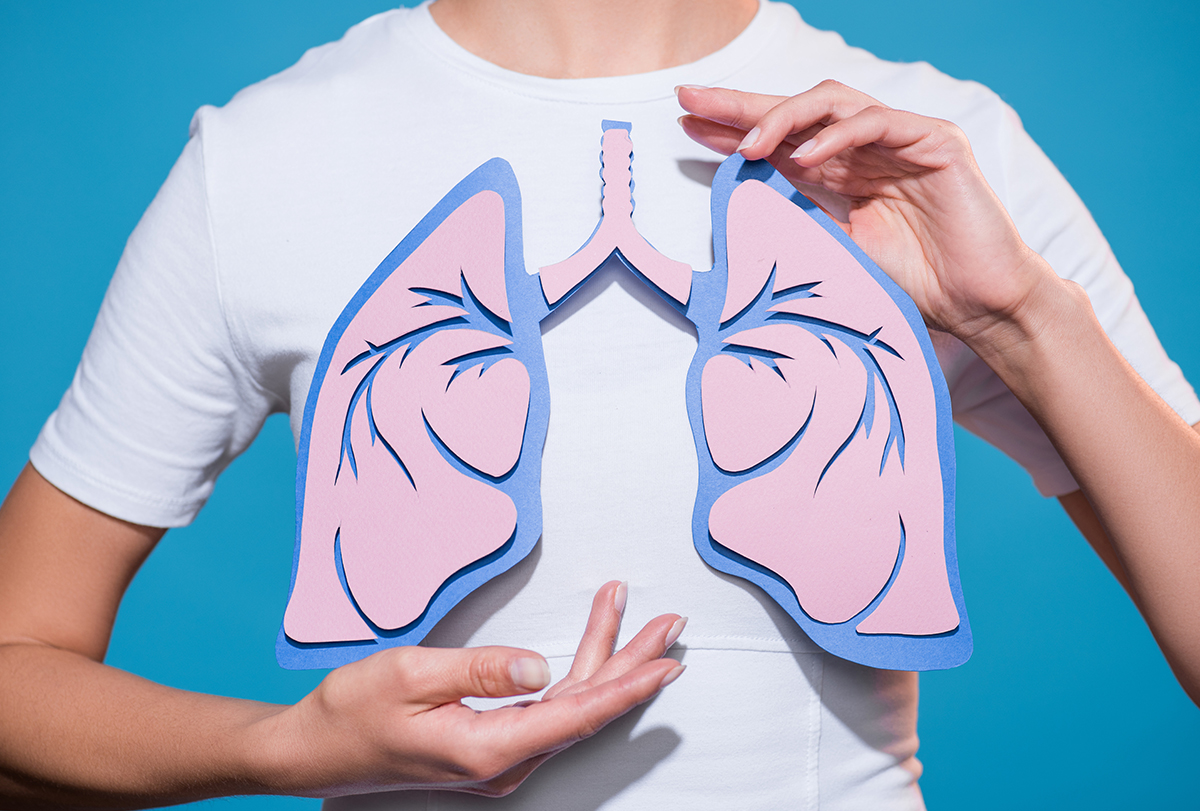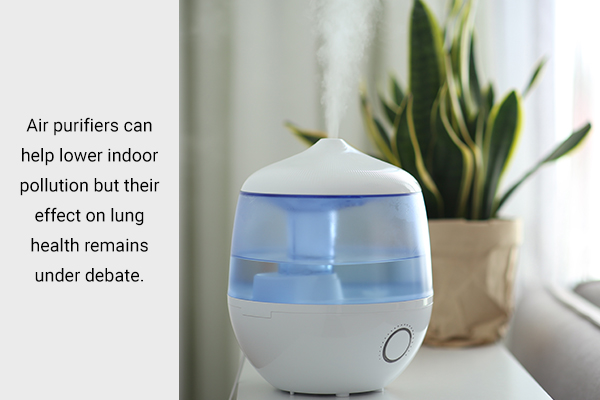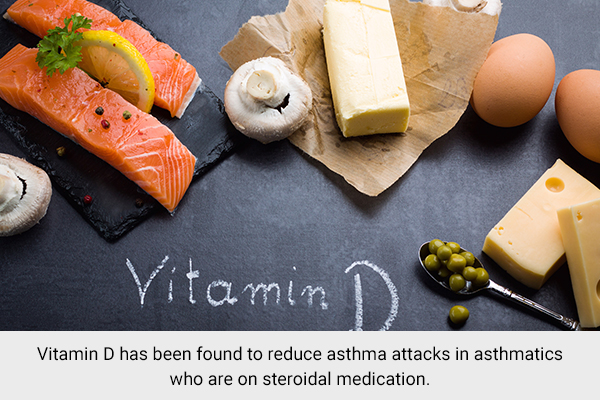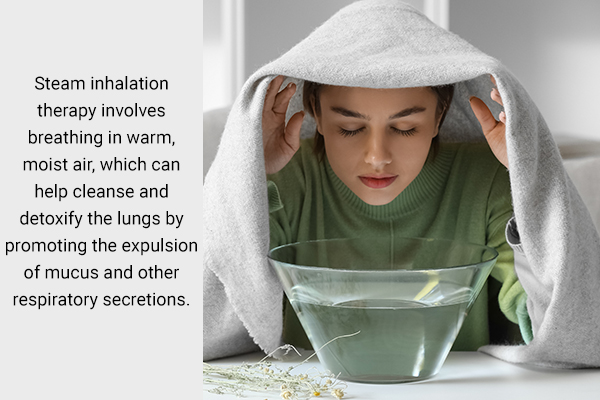In this article:
Your lungs are crucial organs that perform important functions for your body. However, like any other part of your body, you must maintain the health of your lungs by detoxifying and cleansing them.

In today’s world, air pollution is a major threat to lung health, and it’s essential to take action to clean your lungs. Although your lungs have a natural ability to heal and cleanse themselves, you must still do your part in keeping them healthy.
This is especially important for people with lung disorders such as asthma, COPD, allergies, and cystic fibrosis. If you smoke or are exposed to secondhand smoke, it’s even more important to put extra effort into detoxifying your lungs. (1)(2)
Ways to Cleanse and Detox Your Lungs
Here are some ways you can naturally cleanse your lungs.
1. Do breathing exercises
To sustain life, breathing is an essential activity, but aside from that, adopting certain breathing techniques through exercises can be highly advantageous for your lungs.
Breathing exercises can enhance the function of your lungs and prevent damage, particularly for individuals who smoke or have respiratory ailments.
A well-known breathing exercise, belly breathing or diaphragm breathing, involves the movement of the diaphragm. Additionally, popular yoga routines such as pranayama and surya namaskar also include breathing exercises. (3)(4)
To perform diaphragmatic breathing:
- Sit or lie down comfortably.
- Place one hand on your chest and the other on your abdomen.
- Inhale slowly and deeply through your nose, allowing your abdomen to expand while keeping your chest still.
- Exhale slowly through your mouth, gently pressing your abdomen inward.
- Repeat for several minutes, focusing on the feeling of your diaphragm moving with each breath.
- Gradually increase the duration of your diaphragmatic breathing over time, aiming for 5–10 minutes per session.
2. Invest in an air purifier

Indoor air pollution is a major concern as it can be hazardous to health. There is no doubt that air purifiers can help lower indoor pollution, but their effect on lung health remains under debate.
A study conducted by Johns Hopkins Medicine pointed out that using air purifiers can help improve respiratory health. The study found that people with chronic obstructive pulmonary disease (COPD) experienced improved symptoms after using portable air purifiers indoors. (5)
Another study reported that air purification is beneficial for people with asthma by giving them symptomatic relief. Similarly, air purification has been shown to improve lung health in the elderly.
These positive effects of air purifiers are likely due to the purifiers’ ability to filter out harmful particles in the air such as allergens, making it easier to breathe and reducing airway inflammation. However, some other experimenters argue that the effect of air purifiers on lung health and function in everyday life is insignificant and shows no favorable results.
Furthermore, researchers say the use of air purifiers for pulmonary health is controversial and the results depend greatly on the number of people residing in the home, their medical history, and also the location of the house.
In conclusion, using air purifiers is a personal choice. If you wish to lower indoor pollution levels, you can certainly get a purifier for your place. (5)(6)
3. Quit smoking
Smoking for many years damages your lungs and air sacs. Fortunately, quitting can initiate the healing process.
If you’re a smoker, it’s crucial to quit as soon as possible and use nicotine patches or other treatments to help with withdrawal symptoms.
If you don’t smoke, it’s vital to resist peer pressure and continue to stay smoke-free. (7)
4. Stay away from artificial scents
Nowadays, scented candles, waxes, and air freshening sprays with artificial fragrances are becoming increasingly popular. However, continuous inhalation of these products can expose your lungs to harmful chemicals.
If you’re someone who enjoys scents, it’s better to choose products with natural fragrances and herbal ingredients that won’t damage your lung health.
Additionally, many of the cleaning sprays used to clean surfaces in our homes contain chemicals with added fragrances. Whenever possible, it’s recommended to use natural cleaning products instead. (8)
5. Go for chest physiotherapy

Chest physiotherapy techniques such as manual chest physiotherapy (MCP) involving percussion, vibration, and shaking have been used for a long time in the treatment of respiratory conditions.
MCP involves the external manipulation of the thorax using percussion and vibration techniques, which dislodges bronchial secretions that are then cleared. The purpose of MCP is to improve ventilation-perfusion ratios and lung function by removing sputum from the airway. (9)
Chest physiotherapy may require professional aid but can also be done by friends, family, or your partner. You can also sign up for this at your nearest hospital or physiotherapy clinic. (10)
To do chest percussion for someone you know:
- Clap on the person’s chest wall over the part of the lung to be drained for about 3–5 minutes. This helps move mucus into the larger airways.
- Encourage the person to cough or huff forcefully to get the mucus out of the lungs.
The majority of the movement should come from the wrist, with the arm relaxed to reduce fatigue. Correct hand positioning prevents pain or discomfort during percussion.
It is crucial to avoid percussion over specific areas, such as the spine, breastbone, stomach, and lower back or ribs, as this could cause harm to internal organs such as the liver, spleen, or kidneys. (10)
To perform the vibration technique for someone you know:
- Place a firm hand on the chest wall over the area of the lung to be cleared.
- Tense your arm and shoulder muscles to create a gentle shaking motion.
- Apply light pressure on the area being vibrated.
- Ask the person to exhale slowly and completely during the process. (10)
6. Go outside for clean air
Getting some sunshine and fresh air is of utmost importance. Fresh air is crucial for your lungs to function properly and relax. It is advisable to opt for open spaces with minimal housing, as they are less polluted, for a walk.
It is essential to avoid areas where people burn waste, industrial factories, or areas with heavy traffic as harmful pollutants are released in the air that can adversely affect your lungs. If you are passing through such areas, it is recommended to wear a mask that filters the air to prevent inhaling these chemicals. (11)
7. Eat right

Including certain nutrients in your diet can significantly improve the health of your lungs. Vitamin D is one such nutrient that has been found to reduce asthma attacks in asthmatics who are on steroidal medication.
Foods rich in vitamin D that can be added to your diet include milk, cereals, oatmeal, yogurt, fish, eggs, mushrooms, butter, orange juice, cheese, and soy products.
Antioxidants are also essential for maintaining good respiratory health. A diet rich in antioxidants can soothe your airways and improve your breathing.
Some foods that are rich in antioxidants are dark chocolate (with low sugar), berries, eggplant, beans, sprouts, tomatoes, citrus fruits, nuts, and seeds. (12)(13)
8. Perform aerobic exercise
Aerobic exercise is widely recognized for its ability to enhance lung function and capacity. It can increase your lung strength, enabling you to perform daily activities without fatigue.
Examples of aerobic activities that you can incorporate into your routine are taking a morning or evening walk, going for a brief run, cycling daily, swimming for a few minutes, dancing to your favorite songs, participating in boxing or other sports, and trying out a Zumba class. (14)
9. Clean filters in the house
It is essential to maintain clean air filters in your home to ensure good indoor air quality and promote good lung health.
Research has shown that indoor air pollution is a complex mixture of agents that can have adverse health effects, particularly for vulnerable populations such as children, the elderly, and women who spend more time indoors.
One effective way to reduce indoor air pollutants is by using efficient air filters in various household appliances such as air conditioning units, heating units, exhausts, and washroom vents. It is also important to regularly clean furnace filters, chimney filters, and other filters in your home appliances to ensure they continue to work effectively.
In summary, maintaining clean air filters in household appliances is crucial for ensuring good indoor air quality and promoting good lung health. (15)
10. Perform steam inhalation

Based on research, steam inhalation therapy can be a contemporary approach for managing respiratory conditions, including COVID-19.
Steam inhalation therapy involves breathing in warm, moist air, which can help cleanse and detoxify the lungs by promoting the expulsion of mucus and other respiratory secretions. This is particularly relevant for individuals with respiratory infections.
While steam inhalation therapy is generally safe, precautions need to be taken to avoid burns or scalds, especially in younger children and older adults. Additionally, it is important to note that steam inhalation therapy should not replace medical treatment.
In conclusion, steam inhalation therapy can be beneficial for cleansing and detoxifying the lungs. (16)
To perform steam inhalation:
- Boil water in a pot or kettle and then pour it into a large heat-resistant bowl.
- Place your face directly over the bowl, with a towel draped over your head to create a tent-like enclosure.
- Breathe in the steam through your nose for 5–10 minutes.
- Take breaks if the steam feels too hot or if you feel lightheaded.
- After you’re done, gently blow your nose and wash your face with cool water.
- Clean the bowl and any utensils used for the inhalation.
11. Try herbal drinks
a. Mint tea
Mint tea and infusions made from mint (Mentha x piperita L.) have been reported to be beneficial for respiratory health. These remedies are commonly used to alleviate coughs and are also used in inhalations to alleviate congestion in the nose.
Incorporating mint tea into your routine may offer respiratory benefits, as well as potential relief from digestive discomfort. (17)
To make mint tea:
- Boil water in an electric kettle or on the stove.
- While the water is heating up, rinse a handful of fresh mint leaves under running water.
- Once the water has boiled, pour it into a teapot or mug.
- Add the mint leaves to the teapot or mug.
- Let the mint leaves steep in the hot water for about 5–10 minutes.
- After steeping, strain the tea to remove the mint leaves.
- If desired, add a sweetener such as honey or sugar to taste.
- Enjoy your freshly brewed mint tea!
b. Ginger tea
Ginger has been shown to have beneficial effects on respiratory health.
Ginger is a natural plant that may help improve lung health in those who have lung problems caused by too much oxygen and inflammation. Ginger helps protect the lungs from damage and reduce inflammation in the body. (18)
To make ginger tea:
- Wash and peel a piece of fresh ginger (about 1–2 inches).
- Slice or grate the ginger into small pieces.
- Add the ginger to a pot of water (about 2–3 cups of water) and bring it to a boil.
- Let the ginger steep in the water for 5–10 minutes, depending on how strong you want the tea to be.
- Strain the ginger pieces from the tea and add honey or lemon for flavor, if desired.
- Serve the ginger tea hot and enjoy!
Most-Asked Questions About Lung Health
Is vaping bad for lung health?

Vaping is the act of inhaling and exhaling vapor produced by an electronic cigarette or similar device. It is true that vaping has been known to provide the lungs with harmful chemicals. It can be linked to severe lung diseases.
Moreover, vaping worsens asthma and other existing lung diseases. Also, lung injury is more commonly observed in people who use vaping products. (19)
What are VOCs, and why are they bad for lung health?
Volatile organic compounds (VOCs) make up a good fraction of major sources of air pollution. They are known to cause: (20)
- Lung irritation
- Lung damage
- Worsening of COPD
- Asthma
- Throat discomfort
- Allergies
- Dyspnea
What fruits are good for the lungs?
According to one review, nutrition has a significant impact on obstructive lung disease, especially antioxidant vitamins such as vitamins C and E. Antioxidants can reduce the harmful effects of oxidants on the lungs and potentially prevent chronic lung diseases and damage to lung function.
Studies have shown that taking vitamin C supplements can have a short-term protective effect on airway responsiveness and pulmonary function. Vitamin C-rich foods include strawberries, tomatoes, and Indian gooseberry. (21)(22)
Final Word
From supplying oxygen and purifying the blood, the lungs ensure you are living a healthy life.
When you breathe, you inhale more than just air – you inhale dirt, smoke, and a lot of pollutants that harm your lungs. For this reason, it is important to detox your lungs and take care of your respiratory tract.
- Was this article helpful?
- YES, THANKS!NOT REALLY


